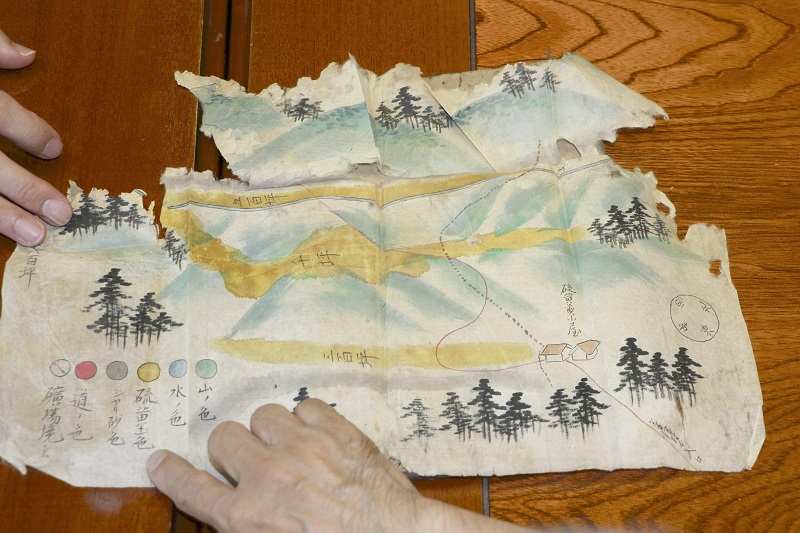Map of sulfur mining sites discovered, possibly drawn by intl trading pioneer

A map showing sulfur mining sites that is believed to have been drawn by Nakaiya Jubee
15:00 JST, August 7, 2022
TSUMAGOI, Gunma — Shedding new light on the achievements of international trading pioneer Nakaiya Jubee (1820-61), a map of a sulfur mine on Mt. Kusatsu-Shirane that is believed to have been drawn by Nakaiya has been discovered in his hometown of Tsumagoi, Gunma Prefecture.
Nakaiya, whose real name is Kuroiwa Jubee, was a raw silk trader who was active in Yokohama when Japan was at a turning point in its history and just beginning to modernize. Through his business, Nakaiya greatly contributed to laying the foundation for Yokohama as an international trade hub and port city.
Before becoming a merchant in Yokohama, Nakaiya wrote a guide on mining sulfur and using it to produce gunpowder, titled “Shuyo Hoyaku Shinsho” (Collected new text on gunpowder). The discovered map is believed to be closely related to the guide.
The guide was published in 1855, two years after U.S. Commodore Matthew Perry sailed into the harbor of Uraga in Kanagawa Prefecture. At the time, national defense was a critical issue, and there was an urgent need to increase gunpowder production.
A specialist said that the presence of the map helps confirm that the guide was written based on real experience, not merely oral recollections or interviews.
The hand-drawn map is about 30 centimeters long and 40 centimeters wide.
It was found in June in the storehouse of Koichi Kuroiwa, 72, a descendent of Nakaiya.
The map was examined by Takeomi Nishikawa, director of the Yokohama Archives of History.
Although partially damaged, the map clearly shows three sulfur mining sites marked in yellow at the foot of the mountain. A road connecting to storage sites for the mined sulfur is depicted in red.
The text on the guide reads, “sulfur produced from Mt. Shirane in the Joshu region ranks as the highest quality sulfur,” followed by a detailed explanation of mining methods.
Nishikawa said: “It is thought that Nakaiya himself was involved in the mining and drew the map.”
The map says “Entrance from Kusatsu Village [present-day Kusatsu Town]” and that the total area of the three mining sites was 1,800 tsubo (about 5,950 square meters). Reportedly, it may be possible to locate exact mining spots if related historical material is discovered.
Nishikawa said that Nakaiya had close ties with Japanese scholars of Dutch studies. A group of some of these scholars strongly suggested the Tokugawa shogunate government increase gunpowder production. Some others insisted that foreign currency should be obtained through trade in addition to strengthening national defense.
“Against this backdrop, Nakaiya started a business in Yokohama while keeping in touch with enlightened bureaucrats of the Tokugawa government,” Nishikawa said.
Nakaiya was born in Nakai Village (present-day Mihara district of Tsumagoi Village). He started a store called Nakaiya in Yokohama immediately after the opening of Yokohama Port to sell raw silk mainly produced in Gunma and Nagano prefectures to foreign trading companies.
In 2003, a monument marking Nakaiya’s contributions was erected at the former site of his store in Naka Ward, Yokohama. In 2016, the ward and Tsumagoi signed a friendship exchange agreement.
Exhibition in Yokohama
The mining and gunpowder production guide written by Nakaiya and his diary recording such matters as trends within the Tokugawa government up to the opening of Yokohama Port will be on display at an exhibition to be held at the Silk Museum in Naka Ward, Yokohama, from Oct. 1 to Nov. 13.
This will be their first public display outside Tsumagoi Village.
“I hope many people will be able to deepen their understanding of Nakaiya,” Kuroiwa said.



